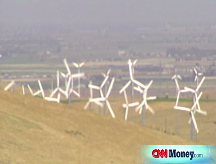Stimulus 101: What's in the bills
The plan by Obama and congressional Democrats to revive the economy is taking shape. Here's what we know so far.
NEW YORK (CNNMoney.com) -- You've probably noticed: The Obama administration and Congress are talking about spending an unprecedented sum of money to try to revive the economy.
President Obama and House Democrats laid down the marker with an $825 billion package of spending and tax cuts. The Senate version will be taken up by two committees on Tuesday.
Dozens of proposals. Hundreds of pages of legislation. Billions of dollars.
What are some of the headline proposals, and what is the debate all about? The legislation is a work in progress, but here is an overview.
The case for it: By investing in renewable energy, health care, education and modern construction projects, the Obama administration expects to create between 3 million and 4 million jobs and address key sustainability issues.
The case against it: Opponents argue the spending will lead to a rapidly increasing and unsustainable deficit. They also say that a majority of infrastructure projects will take too long to implement.
Construction projects: $90 billion. Fund the rebuilding of crumbling roads and bridges, build clean water and flood-control mechanisms and provide funding for mass-transit systems.
Education: $142 billion. Rebuild thousands of schools by modernizing classrooms, labs and libraries.
Renewable energy: $54 billion. Double production of alternative energy in the next three years. Weatherize low-income homes, modernize 75% of federal buildings and update the nation's electrical grid with a new, cost-efficient "smart" grid.
Health-care records: $20 billion. Modernize the health care system by computerizing all of the nations' medical records in the next five years.
Science, research and technology: $16 billion. Invest in science facilities, research and instrumentation to create new industries, new jobs and medical breakthroughs. Expand broadband Internet access in rural and underserved areas.
The case for it: As states face budget shortfalls, Obama's plan seeks to help states pay for Medicaid and unemployment benefits. State fiscal relief will be allocated to prevent increases in state and local taxes, or cuts in government services.
The case against it: Opponents say the bill should focus on job creation that will make an immediate impact the economy.
Medicaid: $87 billion. Increase Federal Medicaid Assistance Percentage so states do not have to cut eligibility for Medicaid due to budget shortfalls.
Law enforcement: $4 billion for states and municipalities for law enforcement.
The case for it: Obama proposed temporary programs to protect those most vulnerable to the effects of the recession.
The case against it: As with state budget relief, opponents say the bill is too big and should simply aim to create new jobs. Some lawmakers have said some of the "safety net" spending provisions are wasteful, and many have called the bill unfocused.
Unemployment benefits: $43 billion. Extend through December 2009 emergency unemployment insurance assistance to states. Increase weekly unemployment benefits by $25, and provide incentives for states to expand unemployment coverage.
Cobra: $39 billion. Tax credit for recently laid-off employees to help pay for discounted health care. Obama estimates the plan will help 8.5 million people who recently lost their jobs.
Feeding the hungry: $20 billion. Increase food stamp benefits by 13%, and provide support for food banks, school lunch programs and WIC.
The case for it: Throughout his campaign, the president pushed for tax cuts for low- and middle-income families. As a form of stimulus, it has the added advantage of being paid out faster than other provisions in the bill, and economists say those income groups are most likely to spend rather than save the money.
The case against it: Opponents say the size of tax cuts for both individuals and businesses do not go far enough and don't make up a big enough portion of the entire package. Furthermore, they oppose giving tax breaks to people who get back more money from the government than they pay in income and payroll taxes.
Middle-class tax cut: $145 billion. Tax cut amounting to $500 a year for individuals and $1,000 for couples. The full credit would be limited to those making $75,000 or less ($150,000 or less for workers filing joint returns).
Low-income tax cut: $5 billion. Expand the Earned Income Tax Credit, which is a refundable credit for low-income workers. Furthermore, the Make Work Pay Credit would be refundable, meaning that even tax filers without any tax liability - typically very low-income workers - would receive one.
Child tax credit: Up to $18 billion. Temporary increase in the amount of the child tax-credit that would be refundable.
The case for it: Obama's plan seeks to help ease the tax burden for small businesses, as well as allow companies suffering losses because of the downturn to get some tax relief by applying losses to more years in which they booked a profit.
The case against it: Opponents say too small of a percentage of the total package - 2.7% - goes to small businesses, and to businesses in general.
Small business write-offs: Obama would increase the amount of expenses small businesses can write off to $250,000 in 2009 and 2010 from the current $125,000 level.
Tax cuts for companies suffering losses: Up to $17 billion over 10 years. Obama would temporarily broaden the "net-operating loss carryback" to five years, up from two years currently. The provision would let companies apply their 2008 and 2009 losses to past and future tax bills so they can get money back on taxes they've already paid or would otherwise have to pay.
How do you think Barack Obama's presidency will affect you and your wallet? What can he do to help you - and others - in these trying economic times? E-mail us at realstories@cnnmoney.com, and your thoughts could be part of an upcoming story. ![]()



